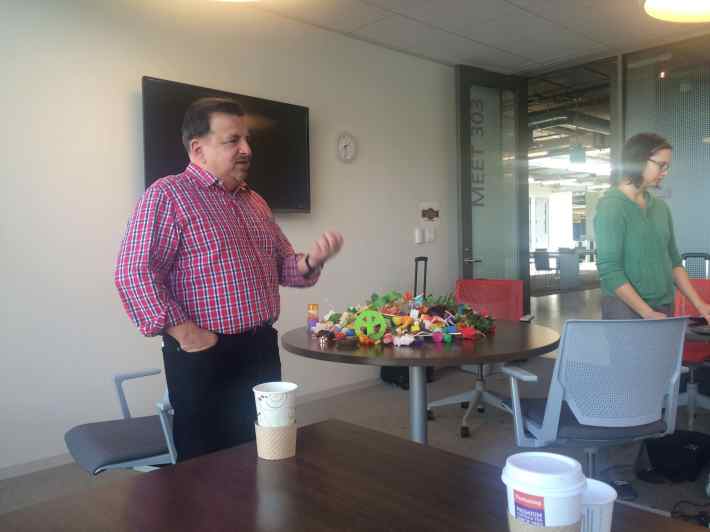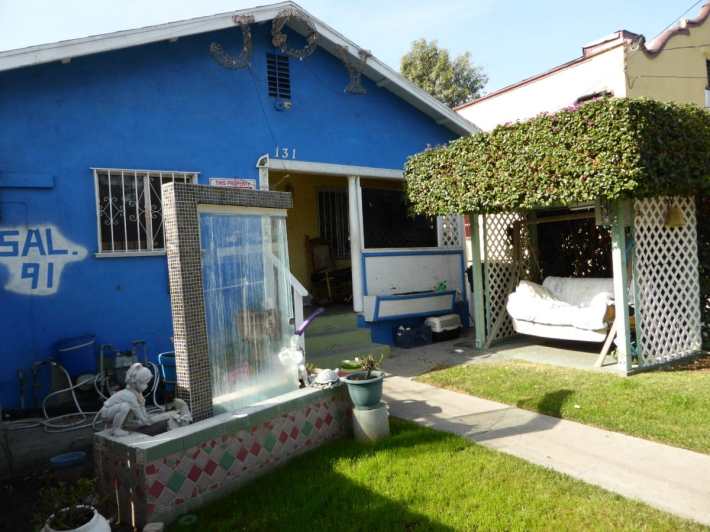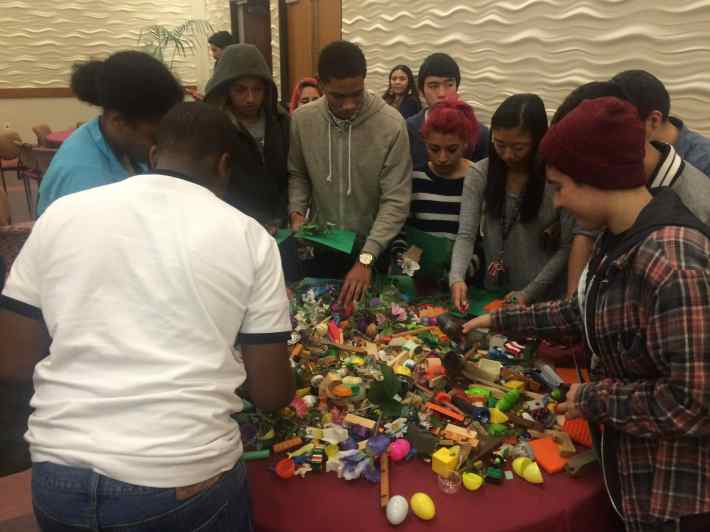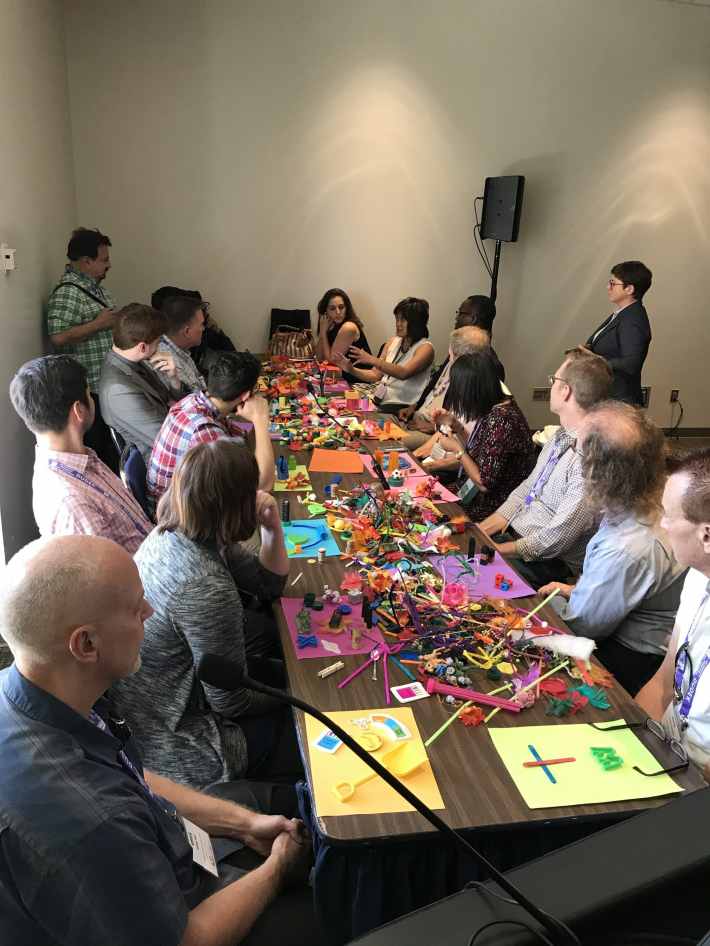rchitecture and city planning have done little to accommodate communities of color in our city,” writes Judith Baca in her landmark essay,“Whose Monument Where: Public Art in a Many-Cultured Society.” Los Angeles history provides countless examples of Baca’s point considering the half-century reign of restrictive housing covenants, redlining, the erasure of Chavez Ravine, the five freeways cutting through East L.A. and Boyle Heights, the hundreds of homes demolished for the freeways cutting through West Adams and South Central and the destruction of the original Bunker Hill.
There’s no question—Baca is right.
On the contrary, though, people of color have done a lot for architecture and urban planning. James Rojas is an urban planner from East Los Angeles that humanizes public space by trumpeting a soulful philosophy he calls Latino Urbanism. He encourages us to be more mindful of how we move through the city.
His progressive vision offers new solutions for both sustainability and social cohesion. In a recent talk at East Los Angeles College, he said that five key facets of Latino Urban Design are: “Sensory, economic, cultural, and social preservation, Rasquache-Improvised, Art-making and serving memory, needs, and aspirations.”
For Rojas, Latino Urbanism begins with walking.

“Walking is a visual, spatial, and sensory explosion based on memory, needs, and aspirations,” he says. Rojas believes that the attention you inevitably have to pay while walking is the antithesis of the hurried nature of driving. He sees Latino Urbanism as an intervention where auto-oriented spaces are transformed into more colorful, vibrant, pedestrian-oriented sites that walkers can take in and appreciate as they stroll through them.
Rojas has not owned a car for several years and he lives these values in his own daily practice. He has even said that walking while Latino promotes mindfulness because it is about being in the present and noticing everything around you. He loves murals, hand-painted signs in front of small businesses, or homemade nativity scenes. To Rojas, these interventions soften space and “humanize architecture.” The spirit of Latino Urbanism is something he has meditated on his entire professional career. He worked as a planner for the Los Angeles Metropolitan Transit Authority for 13 years, but now he runs his own firm, “Place It! Interactive Planning.”
One of his critiques about urban planning and many urban planners is that they are disconnected from the neighborhoods they plan and not in tune with the local environment. “While transportation engineers are fixated with time, speed, and destination,” Rojas states, “DIY or ‘rasquache’ Latino mobility interventions focus on the moment or journey. Through these interventions based on memory, needs, and aspirations, many Latinos transform auto-centric streets into pedestrian-friendly zones for community interaction, and cultural expression. Latinos walk with history of the Americas coupled with Euro-centric urbanism, which creates mindfulness mobility helping us to rethink our approach to mobility in the wake of global warming and mental health.”
It Helps to Walk the Walk
Rojas was born in Boyle Heights at White Memorial Hospital and has lived most of his life in Boyle Heights, East L.A., Montebello, and Alhambra. He’s been honing his ideas for over 30 years dating back to the late 1980s when he wrote his Master’s thesis at the Massachusetts Institute of Technology (M.I.T.). Long before M.I.T. though, it was his childhood walking around the Eastside that got him thinking about urbanism.
His memories of walking around his childhood neighborhood are where he first started paying attention to the details that make up a community. “Living a few blocks from Montebello at the East L.A. border,” he remembers, “I would walk over there to see my nino and nina. I remember the housing was very orderly. Walking from East Los Angeles to Montebello, it was a world away. In Montebello, everyone had perfect lawns. I always wondered where our East L.A. lawn fit into that picture. Lawns were how Americans became team players.”
Just because you haven’t heard of rasquache doesn't mean you haven't experienced it. On one hand, the term refers to use of at-hand materials like broken plates, heaps of plastic, or recycled wire for decorating. But it can also mean embellishing repurposed or cast-aside items with personal and cultural flair. While most commonly associated with Chicanx communities, rasquache might be thought of as a more global and intercultural aesthetic of “making do.”
These early walks were the start of his life’s work. A few of his aunts and other close family friends gave him the inspiration that he started to cull into Latino Urbanism. Among the several products of Latino Urbanism that Rojas endorses, perhaps the most pronounced is social cohesion.
Social Cohesion in the Front Yard
Social cohesion centers around the front yard and front porch. In Latino Urbanism, Rojas says that the threshold for social interaction with your neighbors and the world is the front gate. Conversations happen between neighbors across fences. Homegrown fruits and vegetables may be exchanged or long talks in the front yard with family and friends all happen near fences, gates, or the sidewalk. Rojas wrote an article in 2014 “Latino Vernacular” that explicates this concept.
In this essay he explains: “Latino single-family houses ‘communicate’ with each other by sharing a cultural understanding expressed through the built environment. The residents communicate with each other via the front yard. By building fences they bind together adjacent homes. By adding and enlarging front porches, they extend the household into the front yard. These physical changes allow and reinforce the social connections and the heavy use of the front yard.”

This is why parties or quinceañeras happen in the front yard. He celebrates the renovated longer front porches, homemade shrines and customized archways that are often added on to promote this social interaction in the front yard.
While in Mexico the word “rasquache” usually refers to something that is mediocre or something that is half-assed, the connotation has evolved to mean vastly the opposite in the United States. For Rojas, Rasquache is the spontaneity and free expression demonstrated within Latino Urbanism.
Over the last few decades, Rojas has given hundreds of talks and workshops with his firm, “Place It! Interactive Planning.” In his workshops, he asks community members to use everyday objects like Popsicle sticks, legos, and color construction paper to get them to do urban planning visioning. This art-making breaks from orthodox community outreach and it invites participants who otherwise wouldn’t be interested in participating in urban planning activities. His Place It! approach encourages play. He asks people to tap into their memories and render their values and desires using these familiar objects.
‘Rasquache’ is Spontaneity and Free Expression
The spontaneity of his workshops and creative visioning directly correlates with the Latino word “Rasquache.” This is a meaningful concept to Rojas—especially in the context of Latino Urbanism. Katherine Cooper recently wrote about Rasquache in Architectural Digest. Her explanation sheds light on the concept:
Just because you haven’t heard of rasquache doesn't mean you haven't experienced it. On one hand, the term refers to use of at-hand materials like broken plates, heaps of plastic, or recycled wire for decorating. But it can also mean embellishing repurposed or cast-aside items with personal and cultural flair. While most commonly associated with Chicanx communities, rasquache might be thought of as a more global and intercultural aesthetic of “making do.”
While in Mexico the word “rasquache” usually refers to something that is mediocre or something that is half-assed, the connotation has evolved to mean vastly the opposite in the United States. For Rojas, Rasquache is the spontaneity and free expression demonstrated within Latino Urbanism.
Urbanism is something that Rojas feels goes beyond policy and zoning laws.
In the spirit of the front yards mentioned above, it is about making the most of what you have and making something beautiful from unlikely sources. Examples abound across the Eastside such as “Shrines, hand-painted store signs, Day of the Dead Altars, interventions people make by hand using their imagination and resources at hand, objects that are not store-bought,” he says. Rasquache is about tactile community engagement and reveling in the sensory experience. In his slideshow at ELAC he celebrated pop-up mercados next to bus stops and front-yard plazas selling pinatas.
Urbanism is something that Rojas feels goes beyond policy and zoning laws. The human interaction in the built environment and how people live is what he loves. “The built form is a language,” he says. He wants to transform how planners and people see the city by spotlighting the human connections outside the built form. He’s doing his best to help people get in touch with their community and make space more interactive.
Paying it Forward to the Next Generation of Eastside L.A. Urbanists
This talk at ELAC was especially meaningful to Rojas because that’s where he got his start studying urbanism in 1978 after graduating from Montebello’s Schurr High School in 1977. To Rojas, these students remind him of himself 40 years ago. “It was great to return to speak to students who will be on the same journey as me,” he shares, “discovering themselves, the city, the world. I was like them, very shy, but was able to boost my confidence as I got older by attending Woodbury, going in the Army, MIT, and the Peace Corps.”
The auditorium in the Vincent Price Art Museum at ELAC that day was full and they hung on his every word. “I was able to change the perspective,” he declares “on how 100 young Latino architecture students view their role in reshaping LA from a personal responsibility to a professional one.” He enjoys helping these students see how their lives are a part of a bigger movement.
“James authenticated my experience growing up in East L.A. and Montebello. Through his writings and talks, James explained how Latino and Latina communities uniquely enact cultural values in built form. Epiphanies followed. The front yard-as-living room, that familiar vibe for me growing up but less familiar in traditional suburbia, suddenly made sense as an enacted cultural practice.”
This is why whenever he can speak with emerging architects, design students or future urban planners, especially young Latinos, he savors the opportunity to get them to tune in closer to their surroundings and appreciate the everyday vernacular. Over the years he has come back to speak at ELAC every so often and he always inspires the students. One of them is Jonathan Pacheco Bell, an embedded Urban Planner who grew up in Montebello.

“I met James Rojas in 1997 when I was an architecture student at East Los Angeles College,” Bell says. “This was how I learned about Latino Urbanism. James authenticated my experience growing up in East L.A. and Montebello. Through his writings and talks, James explained how Latino and Latina communities uniquely enact cultural values in built form. Epiphanies followed. The front yard-as-living room, that familiar vibe for me growing up but less familiar in traditional suburbia, suddenly made sense as an enacted cultural practice.”
Rojas’s own evolution as an urban theorist developed from both his daily life and education. Following his time at ELAC, Rojas got his Bachelors at Woodbury University when it was located in Downtown Los Angeles on Wilshire.
His undergraduate studies at Woodbury were in Interior Design. “My interior design education helped me understand how the body connects with the environment through the senses in intimate ways regardless of being indoors or outdoors,” he says. “While interior design is focused on the pristine, I look for the everyday messiness of life. This brings a new perspective on how to understand the complexities of Latino life.”
Woodbury University is now located in a leafy section of Burbank tucked up against the Verdugo Mountains, but for many years “Woodbury was downtown and a commuter school. Mainly white, with three Latinos at the school when I was there. We stood out.” He remembers “they had a switchboard operator and an elevator lady. We would meet at the Cafeteria in the morning.” Rojas will be back at Woodbury on February 10, 2020, to give a talk and lead a workshop.
“The San Gabriel Valley allows people to express themselves through the built environment,” he says. “It has mountains, hills, valleys, water, and sun. I have seen it change from rural, suburban to urban through demographics, infrastructure, and the Latino built environment..."
Rojas also has fond memories of attending Schurr High School in Montebello. “Schurr had a utopian spirit,” he says. “It was a new modern school that reflected the times. The students were white, Latino, Armenian, and Japanese. Students came from Montebello, Monterey Park, and East Los Angeles. Disco was in full swing and there were many aspiring Latino students like myself who had big dreams.”
Rojas’s family has always been in East Los Angeles, Montebello, or Alhambra. His family moved to Alhambra during his college years. I recently met him for a coffee in Alhambra on Main Street and he told me that the Starbucks we were in, once housed a hardware store. He also sees the San Gabriel Valley as a pivotal location for urbanism.
“The San Gabriel Valley allows people to express themselves through the built environment,” he says. “It has mountains, hills, valleys, water, and sun. I have seen it change from rural, suburban to urban through demographics, infrastructure, and the Latino built environment. From the old San Gabriel mission to the Latino front yards, there is a strong presence here. As a teenager, I wanted to leave and I did. Coming back I have a new appreciation for it.”
Queering Urbanism
Rojas views himself more as an urban planning practitioner than a writer but over the years he has written a few manifestos expanding on his ideas of Latino Urbanism. These essays serve as corollaries to his Latino Urbanism and one of his best-known writings is Queer Urbanism. In this seminal essay, he builds on his earlier ideas and asserts several key points. He begins by stating, “I have a strong sense, rooted in my own life and my knowledge of queer lives in general, that queers experience urban space differently from others—and from this awareness, I created Queer Community Visioning Workshops in Los Angeles, San Francisco, and Minneapolis.”
In this essay, he rails against the lack of empathy that often dominates the field of urban planning. “Most planners,” Rojas writes, “Uphold the status quo, making decisions every day based on mainstream, heteronormative values. Often those values include a strictly objective approach that rules out emotion, and a ‘siloed’ process: issues like transportation, housing, and sustainability are addressed in isolation from each other and from wider contexts.”
The workshop aims to deconstruct the heteronormative status quo and to open up the lens to humanize urbanism. He begins by asking participants to use objects to recreate a childhood memory. He instructs them to recreate “a moment when they felt or realized that they were different.”
In both Queer and Latino Urbanism, Rojas revels in celebrating differences and using these elements to promote inclusive design that offers a seat for everyone at the table.
Ultimately a lot of self-discovery and healing happens from these workshops because “the memories reveal LGBTQ people’s struggle, confusion, and perseverance from childhood on—including how they developed a ‘sixth sense’ for how to understand and navigate the heteronormative physical and social world, and to find spaces that welcomed them. This ’sense’ allowed them to coexist with others and understand the complexities of the people and places around them.”
This opening exercise creates empathy between the participants and breaks the ice. Design teams are then formed and they are each asked to create “queer-friendly spaces, parks or queer-utopias.” The resulting designs Rojas notes “embodied themes that are crucial for the queer community: inclusion, equity, nonjudgment, gender safety, openness, access, beauty, comfort, and living harmoniously with nature.”

In both Queer and Latino Urbanism, Rojas revels in celebrating differences and using these elements to promote inclusive design that offers a seat for everyone at the table. “Queer planning, as I experienced it in the workshops and understand it in my own work,” he writes, “begins with embracing and celebrating difference—and for queers, that difference is inevitably connected with powerful emotions.”
The same social cohesion he trumpets in his Latino Urbanism is a core concept in Queer Urbanism. “Queers can make an important contribution to a new vision of planning,” he reveals. “That begins with the lessons of difference and the experience of emotion (including personal pain) and moves forward to find planning solutions that address the whole human being and the whole human community.”
From Walking Meditation to Mindful Mobility
The spirit of creating more inclusive spaces, harnessing emotions, and the recognition of the whole human community is very much in line with his ideas of Latino Urbanism. The profound humanity of Rojas’s vision is why he travels the country leading the Place It! Visioning Workshops and giving talks. Now more than ever we need the social cohesion that he speaks of.
Beyond the practical results Latino Urbanism yields, in many ways, his ideas about 'Walking While Latino' are analogous to Thich Nhat Hanh’s Walking Meditation.
Consumer culture in the 21st century and technology are often antagonists to building community because they are more individualistic practices. Rojas wants us to slow down just a bit to appreciate one another and also notice the sensory landscape around us. This is what he means by mindful mobility.
As traffic, air quality, and other social ills continue to plague our inner cities, the solutions embedded within Latino Urbanism provide some of the most practical answers available. Beyond the practical results Latino Urbanism yields, in many ways, his ideas about Walking While Latino are analogous to Thich Nhat Hanh’s Walking Meditation.
Rojas has a bigger mission connected to expanding what it means to be an urban planner. Whether it be incorporating more queer voices or creating interventions using Latino Urbanism to promote green solutions and social cohesion, he is intent on transforming landscapes into more healthy and habitable spaces. He is bringing art and spirit into a field that for too long has been disconnected from the people it serves.
He also relishes the ability to inspire the next generation through talks at places like ELAC. “I like to inspire all the up and coming Latino architects, urban planners, and designers.” He declares, “To embrace their spatial culture by incorporating it into their professional work to grow this movement. These are the future change agents!”
Contemporary urban planners like Jonathan Pacheco Bell reveal that Rojas is leading the charge. “James was the first practicing urban planner I met,” Bell confesses. “He carved out a path for me. His work was formative in my thinking about space. When I eventually changed career pathways from architecture to urban planning, I did so with a deep appreciation of enacting one’s values and culture, thanks to James Rojas.”
As Judy Baca declared, the history of Urban Planning in Los Angeles is fraught with a racist past against people of color. Nonetheless, James Rojas is showing the world that the future of Urban Planning can look to solutions like Latino Urbanism for an antidote to the mess we are currently in. Rojas’s ideas have gained traction and in addition to speaking all over the country and internationally, his concepts have been written about and expanded on.
“Latinos capitalize on the visual, spatial, and sensory landscape to enhance walking, biking and using public transit...”
One of the most kindred examples is the book Magical Urbanism: How Latinos Reinvent the American Big City written by social historian Mike Davis in 2000. One of the chapters was titled “Tropicalizing Cold Urban Spaces.” This process is exactly what Latino Urbanism does. It revives urban space to transform and tropicalize the landscape.
Latino Urbanism for a More Sustainable City
Ultimately if we are going to create more sustainable cities, we need practical solutions that are effective on multiple levels. James Rojas’s vision with walking and Latino Urbanism is pragmatic on multiple levels. For anyone that wants to see and hear his ideas in action, Rojas will be leading a walk across the Eastside with Los Angeles Walks on January 19th, 2020.
Rojas’s vision of Latino Urbanism is now internationally known and continues to be lauded. Most recently, Island Press just announced that Rojas will be co-writing a book with John Kamp spotlighting something Rojas knows better than just about anyone and that is how to do sensory-based, creative and hands-on ways of doing community engagement with diverse audiences.
Rojas is intent on communicating that: “Latinos capitalize on the visual, spatial, and sensory landscape to enhance walking, biking and using public transit,” he states. “To imagine and create these interventions that support social cohesion, they use art-making with resources at hand to transform the landscape. This approach can help develop meaningful and mindful mobility plans.” Considering the current crazed conditions of our cities, there’s never been a better time for the benefits provided by Latino Urbanism.







